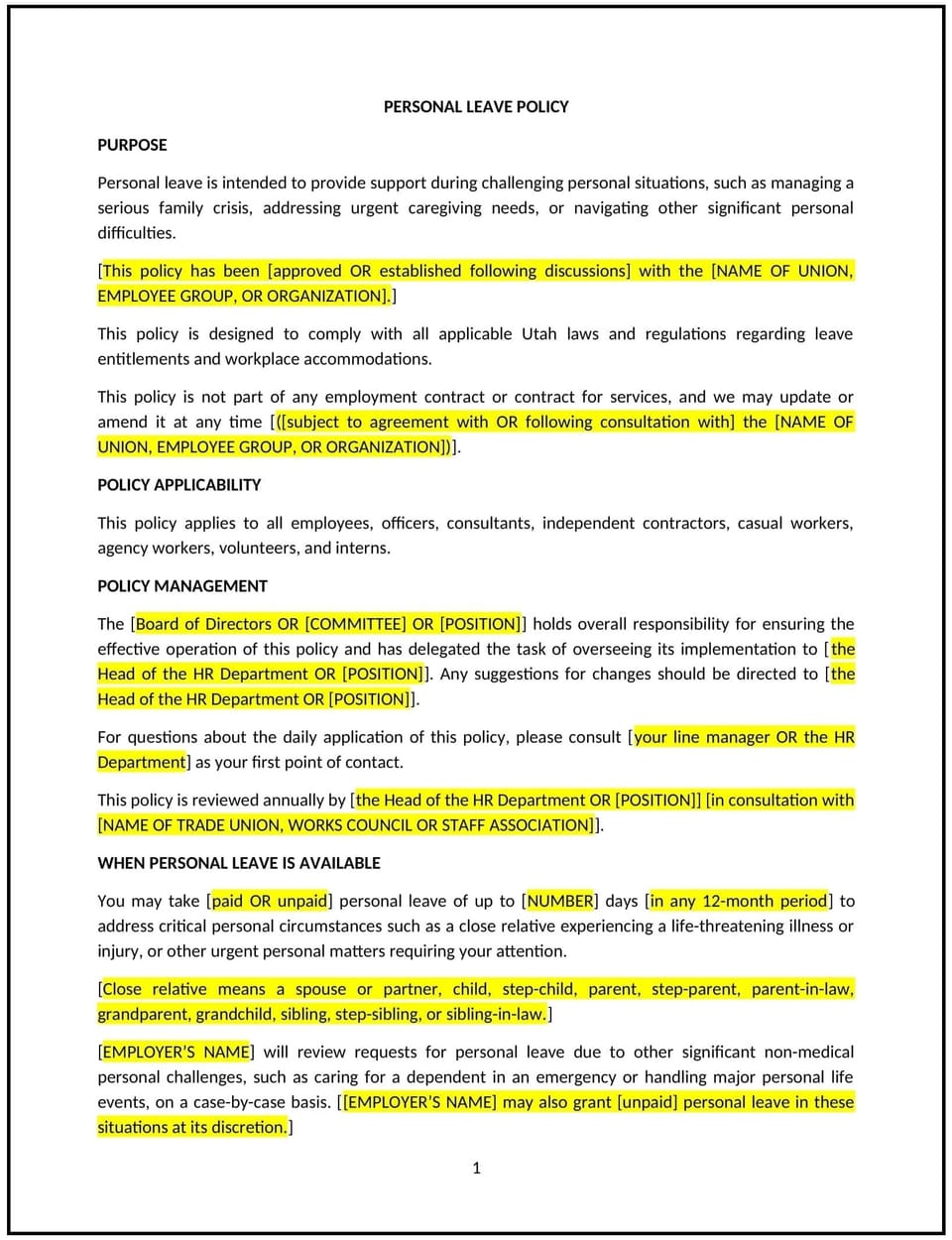Personal leave policy (Utah): Free template

Personal leave policy (Utah)
This personal leave policy is designed to help Utah businesses establish guidelines for employees requesting time off for personal reasons. It outlines procedures for requesting leave, eligibility criteria, and job protection during personal leave.
By adopting this policy, businesses can support employee well-being, maintain productivity, and align with general best practices for leave management.
How to use this personal leave policy (Utah)
- Define personal leave: Explain what constitutes personal leave, such as time off for family emergencies, mental health days, or personal errands.
- Establish eligibility criteria: Specify which employees are eligible for personal leave, such as full-time or part-time staff.
- Set leave limits: Define the maximum amount of personal leave employees can take per year.
- Outline request procedures: Provide steps for employees to request personal leave, including required notice and documentation.
- Address job protection: Guarantee that employees will return to the same or an equivalent position after personal leave.
- Train managers: Educate supervisors on handling personal leave requests and maintaining workflow during employee absences.
- Review and update: Assess the policy annually to ensure it aligns with evolving business needs and employee well-being.
Benefits of using this personal leave policy (Utah)
This policy offers several advantages for Utah businesses:
- Supports employee well-being: Demonstrates a commitment to helping employees balance work and personal responsibilities.
- Enhances retention: Reduces turnover by providing flexibility for employees to address personal needs.
- Aligns with best practices: Offers a structured approach to managing personal leave.
- Reduces legal risks: Minimizes the potential for disputes or lawsuits related to leave management.
- Builds trust: Fosters a positive workplace culture by supporting employees during personal challenges.
Tips for using this personal leave policy (Utah)
- Communicate the policy: Share the policy with employees and include it in the employee handbook.
- Provide training: Educate managers on handling personal leave requests and maintaining workflow during employee absences.
- Monitor compliance: Regularly review personal leave requests to ensure adherence to the policy.
- Address issues promptly: Take corrective action if personal leave requests are mishandled or denied improperly.
- Update regularly: Assess the policy annually to ensure it aligns with evolving business needs and employee well-being.
Q: How does this policy benefit businesses?
A: By offering personal leave, businesses can support employee well-being, enhance retention, and reduce legal risks.
Q: What types of personal leave are typically covered?
A: Covered leave may include time off for family emergencies, mental health days, or personal errands.
Q: Should personal leave be paid or unpaid?
A: This depends on the business’s resources and policies. Some businesses offer paid personal leave, while others provide unpaid leave.
Q: What should businesses do if an employee’s personal leave extends beyond the expected duration?
A: Businesses should maintain open communication with the employee and adjust workflow as needed.
Q: How often should businesses review this policy?
A: Businesses should review the policy annually or as needed to ensure it aligns with evolving business needs and employee well-being.
This article contains general legal information and does not contain legal advice. Cobrief is not a law firm or a substitute for an attorney or law firm. The law is complex and changes often. For legal advice, please ask a lawyer.


